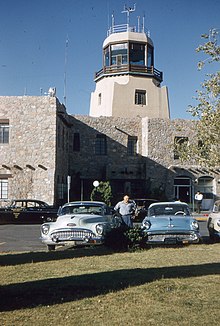El Paso International Airport
The airport was closed by 1945 and in more recent times has been home to the Jobe Concrete Products "Planeport" cement factory.
[6] In 1934, Varney Speed Lines (now United Airlines) operated at the original El Paso Municipal Airport (now closed).
Standard Air Lines began the first scheduled commercial passenger and mail service to El Paso on February 4, 1928, with a route to Los Angeles making stops in Douglas, Tucson, and Phoenix, Arizona.
Maddux used a Ford trimotor aircraft but the service ended later in 1929 by the time of the great stock market crash.
Western Air Express replaced Standard on the route to Los Angeles for a short time in 1930 and extended service eastward from El Paso to Dallas stopping at Big Spring, Abilene, and Fort Worth, Texas.
Through the 1950s, American partnered with Continental Airlines offering an interchange service where American's flights from Los Angeles and San Francisco, stopping in Phoenix, would continue eastward through El Paso as Continental's flights to San Antonio and Houston using the same Douglas DC-6 aircraft.
The interchange flights ended in 1961 when American received its own authority to serve the El Paso-San Antonio-Houston route.
From 1929 to 1931, Mid-Continent Air Express operated a route from El Paso to Denver stopping at Albuquerque, Santa Fe, Las Vegas, NM, Pueblo, and Colorado Springs.
New nonstop service to Dallas began in 1959, and in the early 1960s Continental received its own authority to operate westbound from El Paso to Los Angeles with stops in Tucson and Phoenix.
The service to the smaller cities in southeastern New Mexico ended in 1963 (retiring the DC-3 aircraft) and was transferred to Trans Texas Airlines.
Continental was operating all jets by 1967 and El Paso became a small hub through the 1970s with up to five flights on the ground at a time using a new rotunda shaped gate area on the end of the east concourse.
Service to the Mexican resort cities of Acapulco, La Paz, Los Cabos, Manzanillo, and Puerto Vallarta was operated from 1979 through 1981.
After airline deregulation in 1978, Continental slowly downsized its El Paso operation to flights only serving its hubs at Denver and Houston.
Trans-Texas operated Douglas DC-3 aircraft and flights from El Paso would stop at Marfa, Alpine, Pecos, Ft. Stockton, and several other communities.
In 1969 the carrier changed its name to Texas International Airlines and new Douglas DC-9 jets began flights from El Paso to Houston making stops in Midland, San Angelo and Austin.
Frontier Airlines (1950-1986) began a route from El Paso to Phoenix in 1950 that made stops in Las Cruses, Deming, Silver City and Lordsburg, New Mexico, as well as Clifton, Safford, Globe and Superior, Arizona.
Frontier returned to El Paso in 1963 with a route to Alamogordo and Albuquerque, New Mexico, which eventually continued to Salt Lake City.
Convair 580 aircraft were used on this route and in 1967 Frontier began nonstop flights to Albuquerque and onto Denver with Boeing 727 jets.
Major terminal renovations have been made over the past several years, designed and managed by the local architectural firm MNK Architects.
The El Paso Independent School District (EPISD) began leasing a property on the grounds of the airport in 1963 to house its administrative headquarters.
By the 2010s the City of El Paso desired the use of the property for airport expansion, but chose to defer the original 2014 expiration of the lease to at least December 31, 2019 so EPISD had time to find a new headquarters location.








